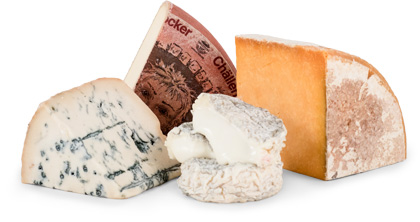Morbier Du Livradois comes to us in a 14-pound wheel from the Morbier region of France. We cut and wrap it in special paper to preserve the flavor and allow the cheese to breathe, which is very important for storing most cheeses. Don’t be put off by the strong aroma that greets you because it is a surprisingly mild cheese made from raw cow's milk, which adds depth to the flavor and imparts a sweet taste. Morbier is aptly named because the word means "small market town." Morbier was originally made by cheesemakers who lived in the village of Morez in the Jura Mountains of France. Situated in a deep valley a few miles from the Swiss border, Morez is now surrounded by ski resorts - Les Rousses, Prémanon, Morbier, Bellefontaine, etc.
About two hundred years ago when Morbier was first made it was made strictly for the cheesemakers consumption. They used left over curd from Comte production. You’ll note the look of this cheese is quite distinctive with its horizontal gray-black line running through its middle. This line is actually a mixture of edible vegetable ash. The cheesemaker would press the leftover curd from the evening's production of Comte into a round mold and cover that curd with a thin layer of ash to prevent it from drying out. The next day he pressed the leftover morning curd on top of the ash. You could tell which layer of the cheese came from the evening milking since it tastes fruitier than that from the morning milking.
Morbier is in the Auvergne region in central France. It lies in the heart of the Massif Central, a mountain range with a chain of long extinct volcanoes—the last eruption was over 6,000 years ago. The province consists of rich farm country with rolling hills and huge forests. The landscape of the Puy-de-Dome and Cantal highlands changes into sweeping glacier valleys, lakes, waterfalls and wide plateaus. There you will find unspoiled medieval towns and mountain villages. And in the wilds of the Livradois, rest remote stone and slate roofed jasseries, burons, or actives – ancient summer farmhouses – on the plateaus.
Much of the flora and fauna common in the wilder parts of France are not found in other parts of Europe. You will see many varieties of wild orchids (e.g., the elderflower, pyramidal, and marsh), the spring anemone, wild pansies and narcissi, maiden pinks, and the great yellow gentian. Clover, all sorts of wild-flowers, and wild onions are some of plants the cows feast on, and what a cow eats flavors the milk they produce and the resulting cheeses. There are country fête held from spring until late autumn to celebrate the harvest and the movement of the herds to and from their mountain pastures. Need we say it’s a charming place to visit?
Contrary to its smell, Morbier has a mild taste and leaves a wonderful, nutty aftertaste. Its flavor is complex and fruity flavor with a slight zing. The ivory-yellow pâte is often described as supple, springy, and silky when touched, yet dry and sticky at the same time. Not only serving as a divide, the vegetable ash separating the cheese layers makes an aesthetic, dramatic presentation and has a complex, bold flavor. Mobier is a cheese that can steal the show on cheese platters. It is often used on sandwiches, melts well and is excellent on salads.

Experience International Variety
You might receive a Gaperon, originating in France during the 14th Century, an
authentic Lancashire by Ruth Kirkham, and an Italian Taleggio matured in the
caves of Valsassina…all in one shipment!

